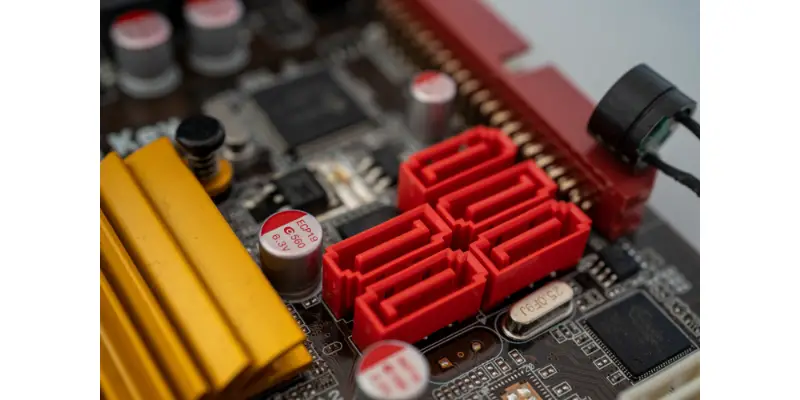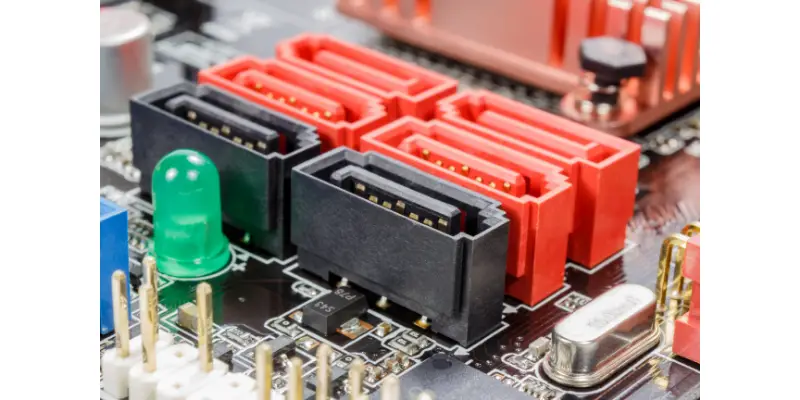Disclaimer: This post may contain affiliate links, meaning we get a small commission if you make a purchase through our links, at no cost to you. For more information, please visit our Disclaimer Page.
You’ve just finished installing or upgrading your computer’s hard drive and now you’re wondering: Which SATA port should I plug it into?
When installing a hard drive, the number on the port does not matter as long as all the ports have similar speeds. Usually, you plug into the SATA port with the lowest numerical number first. But if they operate at the same speed, it will not affect the performance.

Table of Contents
What Are SATA Ports on Motherboard For?
When installing the storage drives to the motherboard, you will likely notice various tags around the port saying “SATA 1” or SATA 2, etc. So, what are these labels exactly?
When you attach the hard drive, the pins on the connector latch to the pins on the controller, which is on the motherboard. But the design of these pins is not random as they are made with certain standards in mind.
One of the most common standards is the SATA or Serial ATA mode. In fact, most of the computers you will see on the market starting from the late 2000s, you can be pretty sure that it utilizes the SATA interface. This is the interface that connects the hard drive (HDD, SSD) to the motherboard.
So, you take a SATA cable and one side to the controller (located on the motherboard) and the other to the actual storage drive.
Now, there are three different generations of SATA, with each generation improving the speed and performance from the previous version. These are SATA 1, SATA 2, SATA 3 respectively.
The first generation of SATA had a speed of 1.5 Gb/s, which was enough to cover most hard drives around that era and some even beyond that. The second generation, SATA 2, improved that speed and took it to 3 Gb/s. This was actually the standard for a long time as it covered all the hard drives available.
SATA 3, the third generation, came about in an effort to integrate solid-state drives or SSDs. These drives operate at a much higher speed and tempo than hard drives. So, to match that performance, SATA 3 was introduced, which can run at a speed of 6 gigabits per second.
In recent times, you have bus interfaces that are even better than SATA such as PCIe and NVMe. People use these advanced interfaces for high-speed external drives. However, SATA is still a major factor and you will find them alongside other types of interfaces on the same motherboard.
For instance, Intel motherboard incorporates both PCLe and SATA ports on their motherboard to allow users great flexibility.
All the SATA ports on the motherboard will have numerical designations, starting from 0.
Does it Matter Which SATA Port You Use?
When it comes to connecting ports on the motherboard, the key factor is speed. Not all the ports operate at the same speed. And the speed of data transmission will rely greatly on the rate the port’s bus interface allows.
So, if you have three SATA 2 ports on your motherboard, all three of them will operate at the same speed. Meaning you can plug in your hard drive to any of the three ports and it will not affect your performance.
Now, most people will attach the ports starting from the lowest numerical number on the ports, which is usually 0. However, this is not too much of an issue. And you will hardly notice any difference in performance.
But, for example, say you connect a SATA 3 hard drive to a SATA 2 port on the motherboard. The motherboard will still be able to read the hard drive and access it to store data. But since the SATA 2 port only allows 3 gigabits per second, you will not be getting the full speed the hard drive was designed for.
So, check which generation of SATA is designated for the hard drive. Then attach that hard drive to the corresponding port on the motherboard and you will be good to go.

Are All the SATA Ports on the Motherboard Identical
Typically, a motherboard will have different generations of SATA controllers on it, especially if it is an older model. This is so that you can attach multiple different hard drives that operate at different speeds. So, you do not necessarily have to throw out your older hard drive. You can still plug it into the motherboard.
However, some motherboards do have identical SATA ports throughout. And in that case, all the storage drives you attach or are planning on using, have to be in the same standard. This is why it is important for you to know the exact port type on your computer.
How to Tell SATA Ports Apart
SATA ports with the same configuration will operate at the same speed. But you will typically find multiple different how can you tell which ports on the motherboard are similar and which ones are not?
Well, in most Intel motherboards, the ports will have labels that specify the type of SATA. And they are written in big letters so it is hard to miss them. The same can be said for a lot of other brand’s motherboards.
Another way to tell them is through their color. Generally, identical SATA ports will come in the same color. So, even if the label becomes unreadable for some reason, you can tell them apart by which hue they possess.
For example, the SATA 3 ports on an Intel motherboard are all blue, while the SATA 3 ports are black.
A safe way to determine the SATA type is to download the configuration or specification chart for your particular motherboard on the internet. Simply type in the model of your motherboard and you will be able to find the info you need.
Can SATA Ports Go Bad?
SATA ports can indeed falter with regular use. The cause of the malfunction can be mechanical such as damaging the cable or the port while installing the drive. So, you do not want to be very rough when plugging the cable.
It can also be due to an electrical shortage or a sudden surge in power. Similar to most electrical equipment, there is a limit to how much power it can handle. And if it receives power well above that limit it will get damaged.
Factory defects can also be a cause. In that case, you will likely be able to return it for a replacement, if you have a warranty or proof of purchase.
How Do I Know If My SATA Ports Are Not Working?
SATA port failure is too uncommon and when it happens it is usually related to problems regarding the hard drive. These are the most common and obvious signs showing that there is a problem with either the actual drive or the connecting points:
- The hard drive is not found.
- BIOS cannot detect the hard drive or the message “No Operating System Found” appears on the startup window.
- Blue screen of death (BSOD)
Remember that the source of the problem can be with the drive, cable, or port. So, to get to the exact source follow these steps:
Step 1: Check for Drive Errors
Check to see if there is an error with the drive. The best way to do this is to test the drive on a different computer and see if it runs normally. If it does, you can move on to the next issue.
Step 2: Test SATA Cable
Try a new SATA cable for the hard drive. If it works, then the problem was with the cable and not anything else.
Step 3: Test the SATA Controller
Do the same testing with a different SATA port on the motherboard. If your hard drive and cable are both fine, changing the port should do the trick.
Conclusion
SATA ports are an integral part of most motherboards. So, it is best to know about these parts in detail so that you can handle any problem that comes along better.
